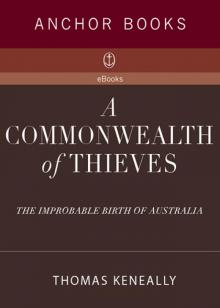- Home
- Thomas Keneally
Australians Page 3
Australians Read online
Page 3
The captain of the Endeavour, James Cook, had a background no more startling than that of his little cat. On 25 May 1768 he was appointed first lieutenant, a rank less than notable for a 40-year-old. He had been born in the winter of 1728 in a two-roomed, clay-built thatched cottage in Marton, Yorkshire, a freezing and hilly region. He came from a lowland Scots father and a Yorkshire mother, a combination not unknown to produce a particular form of sturdiness. Cook had sailed on cats like the Endeavour since childhood, in the Whitby to Newcastle trade along the east coast of England. Years later, between journeys into North American waters, he had succumbed to Venus in the form of Elizabeth Batts of Barking, whom, on a cold day before Christmas 1762, he had married in her parish church of Little Wakering, Essex. The groom was tall, with a small head and a pronounced nose. James Cook was a man utterly without patrons within or outside the British navy, and a man needed such connections to achieve notable rank. Whereas to find a continent, he needed only his native genius, his apparently indestructible soul and his phlegmatic self-confidence.
Early in 1763, soon after the marriage, Cook was appointed a naval surveyor and was absent on the Newfoundland station for five successive summers, until his appointment to Endeavour.
Unlike the later Tahiti-visiting Bligh, he would have no trouble keeping his crew together in Tahiti during the transit of Venus. Cook was a flintier man and not a slave of passion as was Captain Bligh. Cook had the soul of an imaginative functionary, of such talent that if you asked him to survey Newfoundland or find the Antipodes, he would do both with the same straight-faced application, an application, however, of a monumental scale.
Who was this fellow, this apparently two-dimensional naval cipher who greeted the east coast of New South Wales one morning in April 1770? Did he miss a wife, weep for a child? Only Elizabeth Cook, nee Batts, who would live to be ninety-five and die in 1835, who disapproved of his most famous portrait, by Webber, because it made him seem severe, could tell us of the human, sobbing, panting Cook—and did not do so. Other than that, we can surmise he was like the astronauts two centuries later, impermeable to disabling doubt, immutable of faith, unapologetic of skill. He observed all human weakness but was not himself a player in it. In the Webber portrait he has a rugged face turned partly away from us, his Australian children. And when one reads the journals, the face grows no more in human meaning, in the sort of meaning novelists and poets look for. JC Beaglehole’s The Life of Captain James Cook, a definitive work, addresses this question. Were there terrors, were there stresses? Cook certainly punished, in a manner his masters would have described as exemplary, the desertion—for love’s sake—of two of his sailors from Tahiti with their Polynesian mistresses to a remoter island. The elopement led to a mutual hostage-taking by Tahitians and the British, and Cook was concerned not by the stern measures of flogging and clapping in irons to which he sentenced the two men but by the bad relations it generated between natives and the crew.
A moral man who does not seem to have availed himself of any of Tahiti’s carnal pleasures before or after the transit, he abhorred the impact of venereal disease, carried by his sailors in an age when the afflictions of Venus were borne by a large proportion of the male and female population of Europe, on the Tahitians. His own rigorous moral standards were apparently all that his beloved Elizabeth at home in Yorkshire could have asked for.
It could seem that Cook’s ‘coolness and conciseness’ dominated, but he could also be carried away by temper—on a later voyage, an irreverent young midshipman named Trevenen, who had been careless about observations, said that Captain Cook did ‘a heiva’, a Polynesian dance ‘of violent motions and stampings’, to vent his displeasure.
There is good humour, though, in the way Cook related the anger caused by his rejection of the offer of a native girl in the Tongan islands for use as sexual recreation. An elderly woman ‘began first to argue with me and when that failed she abused me . . . sneering in my face and saying, what sort of a man are you thus to refuse the embraces of so fine a young woman, for the girl certainly did not [want] beauty, which I could however withstand, but the abuse of the old woman I could not, and therefore hastened into the boat.’
During his travels, Cook suffered from rheumatism, from a swelling of the groin, and from a condition named tenesmus, a chronic paralysis of the bowels. All of these were maritime ailments, caused by a life in dampness and a regime of salt rations which calcified the urinary tract and cut notches in the colon. One can feel a tenderness for this fellow, his nation’s forerunner, and a shocking apparition to the Eora people of Botany Bay and the Guugu Yimidhirr far to the north, in today’s Queensland, suffering this way, straining above lowered breeches and hose, squatting behind screens of acacia or melaleuca along the coast of which his chart was the first ever made.
THE YOUNG GENTLEMAN
By contrast with aloof Cook, the young gentleman Mr Joseph Banks glimmered with charm. Descended from a family of lawyers who had acquired acreage, Banks was heir to a huge estate at Revesby Park in Lincolnshire, yet was willing for the sake of his mistress, Nature, to confine himself to the narrow, low-ceilinged dimensions of His Majesty’s barque Endeavour for the best years of his young manhood. He would exchange three years of drawing rooms and country houses and splendid English women to collect exotic plants in far places; clearly his avocation, or botanical hobby, was no small thing to him.
Yet Banks had another reason to escape England. He had an understanding with a young daughter of the gentry named Harriet Blosset, but secretly he hoped it would go nowhere. The Endeavour’s extended absence would probably take care of Harriet’s irksome expectations of him.
At a dinner at the house of Lady Anne Monson, an enthusiastic plant collector who had done most of her entirely amateur work in Bengal and South Africa, and after whom the great Linnaeus would name a species of geranium, Banks began to talk the accomplished Swedish naturalist Dr Daniel Solander, one of Linnaeus’s disciples, into joining the Endeavour. First he seems to have induced in Solander a state of excitement, and the next day talked the Admiralty into agreement. Banks chose to take two artists, a secretary, four servants and two dogs on the minute vessel. Tall and personable and exuberant, Banks tended to think that his professional interests should take precedence over the maritime priorities of a narrow Yorkshire salt like James Cook.
Cook’s secret orders referred not just to the observation of the transit of Venus. They also required of him that since the discovery of countries hitherto unknown would redound greatly to the honour of the British nation, he was to proceed to the south in order to make discovery of the southern continent, ‘until you arrive in the latitude of 40 degrees, unless you sooner fall in with it’. If he did not find any signs of the Great South Land (imagined as far more enormous than the ultimate reality of the Australian continent), he was to proceed to 35 degrees east, very close to what would turn out to be the latitude of a large part of the shelving east coast of Australia. He was to persevere until he fell in with the coast or met New Zealand.
Cook’s further orders were, ‘with the consent of the natives’, to take possession of various places in the southern continent in the name of the King of Great Britain. The official orders also compelled the crew, upon their return to Britain, not to divulge where they had been until they had permission to do so, and the logs and journals of officers and petty officers were to be confiscated.
In sentiments which would frequently be denied in the later history of the continent, Dr Charles Morton, President of the Royal Society and a much admired, fatherly figure who would die before Cook’s return, asked him in a document named Hints to exercise ‘the utmost patience and forbearance with respect to the natives of the several lands where the ship may touch. To have it still in view that shedding one drop of the blood of those people is a crime of the highest nature . . . they are the natural, and in the strictest sense of the word, the legal possessors of the several regions they inhabit . . . they may natura
lly and justly attempt to repel invaders.’
Lacking a ship’s chaplain, Cook was to read prayers on Sundays. Banks, of course, believed in the God of Nature, rather than the God of the Anglican Church. He was a deist, like the French thinkers, and his idea of Providence was of an impersonal Being which, ‘careful of the creatures it has created, has benevolently provided against the too extensive multiplication of any species . . .’ Like many sailors, Cook seems to have taken the established religion as a given, a bit like Newton’s laws, and a godly form for control of sailors.
VENUS
The Endeavour crossed the Atlantic and reached Rio de Janeiro, but the viceroy there simply did not believe that this ship, with its scientific gentlemen aboard, was a Royal Naval vessel. Suspecting Cook of either espionage or smuggling, he banned the crew from landing, though some did disembark in disguise. At least, in a nearby bay, Banks and Dr Solander were able to land and collect samples.
Further south, in Tierra del Fuego, Cook managed to find a bay where he anchored and, looking for a watering place, encountered the natives: ‘perhaps as miserable a set of people as are this day upon Earth’. Two of Banks’s black servants died of exposure on this jaunt from the ship, though Banks’s grey -hounds, which had been with their master and may have saved him from hypothermia, survived. At sea again, Cook carefully and definitively charted perilous Cape Horn, saying ‘that the charts hitherto published had been found incorrect not only in laying down the land but in the Latitude and Longitude of the places they contained’.
As in all Royal Naval vessels, floggings for disobedience and worse were a periodic necessity, and Cook saw such punishment as a regulating device in a ship’s population crammed into a tiny space. One young marine stole a piece of sealskin from a comrade, made a tobacco pouch of it, and then hurled himself into the Pacific rather than face Cook and the lash.
Endeavour reached Tahiti more than seven weeks ahead of the transit, and barring some deaths and one suicide at sea, none of the men had scurvy, that tragic-comic disease from maritime melodrama. It is interesting that of all the diseases to which sailors were prone, scurvy frightened them most. It brought on a terrible lassitude, profound depression, acute joint pain, ulcers, tooth loss, appalling breath bespeaking an advancing internal death, and an ultimate closing down of organ function. Dysentery, the bloody flux (a diarrhoea caused by bowel-scarring rations), choleric fevers from bad water, and even yellow fever and typhus were not as universally feared or as statistically lethal as scurvy. On trans-Atlantic, let alone trans-global voyages, scurvy could send men permanently to their bunks and leave ships undermanned or unmanageable. Banks had earlier been worried that he was exhibiting early signs of scurvy and had dosed himself with lemon juice. Cook attributed the defeat of scurvy on Endeavour not only to the care and vigilance of his surgeon, but to the serving of sauerkraut (‘sourgrout’ to the sailors) and portable soup (compacted pea soup), and to dosing anyone who showed symptoms of scurvy with wort or malt.
He had not taken any nonsense about this. Early in the voyage he had ordered men who refused the sauerkraut ration to be flogged. But he had then good-humouredly found more effective methods. ‘The sauerkraut the men at first would not eat until I put in practice a method I never once knew to fail with seamen, and this was to have some of it dressed everyday for the cabin table, and permitted all the officers without exception to make use of it and left it to the option of the men either to take as much as they pleased or none at all . . . The moment they see their superiors set a value upon it, it becomes the finest stuff in the world and the inventor a damned honest fellow.’
Ashore, the enthusiastic Banks impressed the Tahitians by bringing down three ducks with one shot, and began to study the Tahitian language. He possessed the Enlightenment thirst to try out, without prejudice, new cultural habits—he had tattoos done on his arm in Tahiti, in part to see how it was to inhabit a decorated skin. (It hurt a great deal, he found.) Meanwhile, ‘The women,’ wrote Molyneux, the master navigator, ‘begin to have a share in our friendship which is by no means Platonic.’
Within a fortnight of Endeavour’s arrival in Tahiti, a fort had been finished, redoubts of casks with four-pounder cannon mounted on them and six swivel guns sited. The area was named by Cook Point Venus.
In one end of a large tent erected there, an astronomical clock with a gridiron pendulum was rigged in a double frame of wood, fixed firm and as low in the ground as the door of the clock case would permit, and then enclosed in another frame of wood. ‘The pendulum was adjusted to exactly the same length as it had been at Greenwich,’ noted Charles Green, the astronomer, a Yorkshireman of biting wit, in his mid thirties. Towards the end of the tent facing the clock and 4 metres from it stood the observatory, consisting of one of the ship’s clocks, the astronomical quadrant and the reflecting telescopes set up on a steady cask of wet sand. Throughout Friday 2 June, the entire crew was anxious about weather conditions for the transit the next day, but the dawn of the transit was clear, and the day grew witheringly hot.
‘We had every advantage we could desire in observing the whole of the passage of the planet Venus over the Sun’s disc,’ wrote Banks. Cook was on one telescope, Mr Green on another, and both let Doctor Solander take turns. ‘We very distinctly saw an atmosphere or dusky shade around the body of the planet.’ All three observers listed a different time for the various stages of the transit, and so did Lieutenants Hicks and Clarke who had set up their own telescopes to the east, and another party to the west. It was a matter of averaging results of the three observation parties, and calculations were collated in the following days.
After the observations, which he would take back to England for comparison with northern hemisphere measurements and to create a firmer set of longitudinal readings, Cook remained to study the Tahitians with the same keen interest that the Tahitians were studying him and Banks. On 13 July 1769, when the Endeavour left Matavai Bay, Banks had persuaded Cook to bring along Tupaia, a priest, and Tupaia’s servant, a boy named Taiarpa. ‘Thank heaven I have a sufficiency,’ wrote Banks, ‘and I do not know why I may not keep him as a curiosity, as . . . some of [my] neighbours do lions and tigers at a larger expense than he would probably ever put me to.’ Banks was also convinced of ‘the amusement’ of future conversations with Tupaia and ‘the benefit he will be of to this ship,’ given his navigational capacity and his knowledge of the islands of the South Pacific. Tupaia proved his worth through his encyclopaedic knowledge of the reef depths around the islands Cook chose to visit.
At last they left the archipelago on 9 August, Banks putting it thus: ‘Launched out into the Ocean in search of what chance and Tupaia might direct us to.’
Some of Cook’s men were showing signs of ‘venereal distemper’—probably gonorrhoea—from their own private transits of Venus. Cook’s attempt to contain it ‘was to little purpose for I may safely say I was not assisted by any one person in the ship’. The natives insisted to Cook that his men had not brought it to the islands; it had come on an earlier ship named the Dolphin.
THE TRANSIT OF MERCURY
Sailing south with his lovesick, afflicted crew, by September 1769 Cook had reached the point mentioned in his instructions as the first zone of search for a southern continent: 145 degrees west longitude and more than 40 degrees south latitude. The wind blasts of this region hurled the Endeavour about; the men at their mess tables on the crew deck complained all the more because of the lost ease and glories of Tahiti as Cook turned to the north-west. Banks kept working, and in periods of calm weather was rowed about to net jellyfish or shoot seabirds. Banks whimsically described the scene in the cabin: ‘Dr Solander sits at the cabin table describing [sketching] myself at my bureau journalising. Between us hangs a large bunch of seaweed, upon the table lays the wood and barnacles . . . notwithstanding our different occupations our lips move very often.’
When the boy at the masthead, Nick Young, shouted ‘Land!’ he earned himself a pint of rum, a
nd as the east coast of New Zealand’s North Island presented itself more clearly, a headland was named in his honour—Young Nick’s Head. Not that they were certain where they were. ‘All hands seem to agree that this is certainly the continent we are in search of,’ wrote Banks, expecting that this might be a northern coast of a huge southern landmass. But Cook himself was more phlegmatic and estimated that this was New Zealand.
Here Cook had his first crisis with native peoples, and it is sad to behold how far his standards had departed from those urged by Lord Morton in his Hints. The Maori were Polynesians who had occupied New Zealand, which they called Aotearoa, the Land of the Long White Cloud, for about eight hundred years. They lived in fortified villages named pahs, identifiable to Europeans as symbols of existing ownership, but there was no pah here—the Maori encountered by Cook were probably seasonal visitors.
This landing, Cook in the yawl, probably with Banks and Dr Solander, ended ingloriously in a chase of the soon-to-be famous navigator and the soon-to-be illustrious botanist back to the beach pursued by four aggressive Maori men. These natives, so reminiscent of those of Tahiti, would remain far more truculent than the easygoing Tahitians, and for good cause. The pinnace crew, standing offshore, poured in fire against the four, killing one of them. The next morning, Cook attempted a parley ashore, signalled his intentions were friendly, got the Tahitian priest Tupaia to speak to them—the Maori and Tahitian languages were close—and gave gifts. The Maoris plucked them out of English hands— theirs had been the loss, so their fractiousness was understandable, though Tupaia warned both the crew and the Maori that blood conflict would recur unless everyone behaved well. Almost at once, a Maori, knowing that a steel sword would add a new dimension to his warriorhood, began to run away with Mr Green the astronomer’s sword, and someone fired at the man and killed him. The crew of Endeavour thus began a pattern of treating natives as potential thieves rather than actual owners.

 Confederates
Confederates Flying Hero Class
Flying Hero Class Gossip From the Forest
Gossip From the Forest Schindler's List
Schindler's List Bring Larks and Heroes
Bring Larks and Heroes Australians: Flappers to Vietnam
Australians: Flappers to Vietnam The People's Train
The People's Train Crimes of the Father
Crimes of the Father A Family Madness
A Family Madness A Commonwealth of Thieves
A Commonwealth of Thieves Ned Kelly and the City of Bees
Ned Kelly and the City of Bees A River Town
A River Town Bettany's Book
Bettany's Book Blood Red, Sister Rose: A Novel of the Maid of Orleans
Blood Red, Sister Rose: A Novel of the Maid of Orleans Victim of the Aurora
Victim of the Aurora American Scoundrel American Scoundrel American Scoundrel
American Scoundrel American Scoundrel American Scoundrel Three Cheers for the Paraclete
Three Cheers for the Paraclete Australians: Origins to Eureka: 1
Australians: Origins to Eureka: 1 The Power Game
The Power Game The Chant Of Jimmie Blacksmith
The Chant Of Jimmie Blacksmith The Daughters of Mars
The Daughters of Mars Searching for Schindler
Searching for Schindler The Great Shame: And the Triumph of the Irish in the English-Speaking World
The Great Shame: And the Triumph of the Irish in the English-Speaking World Abraham Lincoln
Abraham Lincoln The Widow and Her Hero
The Widow and Her Hero Eureka to the Diggers
Eureka to the Diggers Shame and the Captives
Shame and the Captives The Survivor
The Survivor Jacko: The Great Intruder
Jacko: The Great Intruder The Book of Science and Antiquities
The Book of Science and Antiquities Homebush Boy
Homebush Boy The Playmaker
The Playmaker To Asmara: A Novel of Africa
To Asmara: A Novel of Africa A Woman of the Inner Sea
A Woman of the Inner Sea The Tyrant's Novel
The Tyrant's Novel Australians
Australians Schindler's Ark
Schindler's Ark The Soldier's Curse
The Soldier's Curse Australians, Volume 3
Australians, Volume 3 Blood Red, Sister Rose
Blood Red, Sister Rose A Victim of the Aurora
A Victim of the Aurora The Unmourned
The Unmourned Australians, Volume 2
Australians, Volume 2 To Asmara
To Asmara